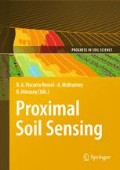Abstract
Spatially dense, geo-referenced information is an integral component of precision agriculture (PA) management. Moreover, the value of temporally dense information is gaining recognition. An example of such valuable information is crop yield data. An intuitively appealing response to these information requirements is simulation modelling. In order to meet the temporal density and the spatial extent requirements of PA, simulation modelling is faced with a major challenge: that of capturing yield variation at a spatial resolution relevant to PA. Adequate computer power to run a representative number of simulations (>1,000) and suitable information to populate the models are the motivating challenges behind this study. Inverse meta-models were derived from the agricultural production simulator (APSIM) using neural network modelling to predict soil-available water capacity (AWC). Using as many years of yield data as was available for a dryland grain farm in Australia, ‘effective’ AWC maps with a resolution of 10 m were made by averaging maps estimated from different yield years. The AWC values were validated in terms of value for predicting spatially variable yield. The AWC maps were significantly different, depending on the year of yield data used. This demonstrated that the ‘effective’ component of the AWC values contains information about climate interacting with the soil, the crop, and the landscape. The AWC values proved useful for predicting yield using simple linear models (0.48 < R 2 < 0.80) rather than using APSIM. A conclusion from this study is that the inverse meta-modelling concept is an efficient way of extracting soil physical information that exists within crop yield maps. Further research attempting to enhance understanding about the ‘effective’ components of the AWC values and to improve the temporal consistence of the AWC values is important. A greater number of AWC scenarios, more years of yield data, and the inclusion of additional information into the meta-models are possible ways forward.
Access this chapter
Tax calculation will be finalised at checkout
Purchases are for personal use only
References
FAO (1998) World reference base for soil resources. Food and Agriculture Organization of the United Nations, Rome
Irmak A, Batchelor WD, Jones JW, Irmak S, Paz JO, Beck HW, Egeh M (2002) Relationship between plant available soil water and yield for explaining soybean yield variability. Appl Eng Agric 18:471–482
Jeffrey SJ, Carter JO, Moodie KB, Beswick AR (2001) Using spatial interpolation to construct a comprehensive archive of Australian climate data. Environ Model Softw 16:309–330
Keating BA, Carberry PS, Hammer GL, Probert ME, Robertson MJ, Holzworth D, Huth NI, Hargreaves JNG, Meinke H, Hochman Z, McLean G, Verburg K, Snow V, Dimes JP, Silburn M, Wang E, Brown S, Bristow KL, Asseng S, Chapman S, McCown RL, Freebairn DM, Smith CJ (2003) An overview of APSIM, a model designed for farming systems simulation. Eur J Agron 18:267–288
Kleignen JP, Sargent RJ (2000) A methodology for fitting and validating metamodels in simulation. Eur J Operat Res 120:14–29
Morgan CLS, Norman JM, Lowery B (2003) Estimating plant-available water across a field with an inverse yield model. Soil Sci Soc Am J 67:620–629
Timlin D, Pachepsky Y, Walthall C, Loechel S (2001) The use of a water budget model and yield maps to characterize water availability in a landscape. Soil Tillage Res 58:219–231
Wong MT, Asseng S (2006) Determining the causes of spatial and temporal variability of wheat yields at sub-field scale using a new method of upscaling a crop model. Plant Soil 283:203–215
Acknowledgements
The authors would like to acknowledge the Grains Research and Development Corporation for funding this work and Malcolm Sargent for providing his farm as a study site and the yield-monitor data.
Author information
Authors and Affiliations
Corresponding author
Editor information
Editors and Affiliations
Rights and permissions
Copyright information
© 2010 Springer Science+Business Media B.V.
About this chapter
Cite this chapter
Florin, M., McBratney, A., Whelan, B. (2010). Inverse Meta-modelling of Yield-Monitor Data for Estimating Soil-Available Water-Holding Capacities at a Farm Resolution of 10 m. In: Viscarra Rossel, R., McBratney, A., Minasny, B. (eds) Proximal Soil Sensing. Progress in Soil Science. Springer, Dordrecht. https://doi.org/10.1007/978-90-481-8859-8_35
Download citation
DOI: https://doi.org/10.1007/978-90-481-8859-8_35
Published:
Publisher Name: Springer, Dordrecht
Print ISBN: 978-90-481-8858-1
Online ISBN: 978-90-481-8859-8
eBook Packages: Earth and Environmental ScienceEarth and Environmental Science (R0)

